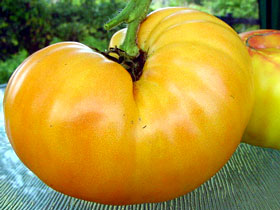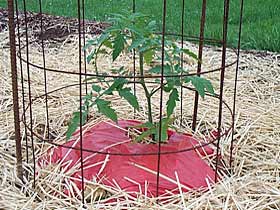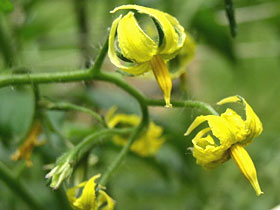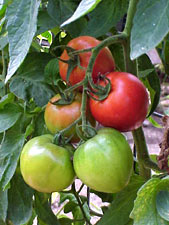Tomatoes are the most popular vegetable grown by American gardeners for good reason. There is nothing like munching on a juicy, sun-warmed, vine-ripened tomato picked fresh off the plant. Whether you like tomatoes fresh, dried, grilled, juiced, or frozen, fresh-picked tomatoes are tangier and sweeter than their supermarket counterparts.

Heirloom tomato varieties, such as 'Persimmon', have sensational looks, soft texture, and sweet and tangy tomato flavor.
But the 'love apple' wasn't always considered a delicacy. When it first appeared in European gardens it was considered poisonous because it's in the deadly nightshade family. The plant was mostly grown as an ornamental, not as the edible crop we know and love today.
But all that has changed. Tomatoes are grown around the world for their luscious fruits. Fruits come in almost all colors of the rainbow, including black and white, and plants range in size from 8 inches to 10 feet tall. The fruits not only taste great, they're good for you as well. Tomatoes are loaded with vitamins A, C, and K and contain the cancer-fighting anti-oxidant lycopene. Plus, they are one of the easier vegetables to grow. Just give them sun and healthy soil and you're almost guaranteed to get some fruits to eat.
In the edible landscape tomatoes are very attractive plants, too. Potato-leafed 'Brandywine' has unusual foliage. Dwarf varieties such as 'Micro-Tom' grow only 8 inches tall and make attractive additions to a window box or small container. Some varieties, such as the 'Silver Fir Tree', actually look like an ornamental tree with silver-green leaves, plus offer delicious fruits.

Cherry tomato varieties, such as 'Sweet Million', provide lots of snack-sized fruits that are great for all kids — young and old alike.
A Central American native, tomato plants love the heat. There's no need to rush them into the soil in spring, since they grow best with soil temperatures above 60 degrees F and air temperatures around 80 degrees F. While tomato transplants are generally available in garden centers and through the mail, if you want to plant a number of varieties or try unusual seedlings, starting tomatoes from seed indoors is the way to go. Start planting indoors under grow lights 4 to 6 weeks before the last frost date in your area. In warm areas with a long growing season, you can sow seeds directly into the soil.
There are hundreds of tomato varieties to choose from. Tomatoes are grouped by various characteristics. You can choose early, mid, and late-season maturing varieties. Dwarf, determinate, and indeterminate varieties refer to the growth and fruiting qualities of the plants. Dwarf and determinate varieties grow to a certain height and produce fruits all at once. Indeterminate plants keep growing and producing fruits until killed by weather, pests, or people.
Tomato varieties can also be grouped according to fruit size and color. Fruit size ranges from small ″currant″ to large ″beefsteak.″ Colors include red, pink, orange, yellow, golden, white, black, and striped. Which varieties you grow is a matter of where you're growing the plants and how you'll be using the fruits. In containers, choose dwarf or determinate varieties that don't grow tall. For fresh eating choose slicing varieties. For snacks and salads choose cherry, grape, or currant tomatoes. For processing, look for meaty paste tomato varieties. You can grow a veritable cornucopia of tomatoes, but the beautiful part is even if you only grow one of each type you'll still get an abundance of fruits.
It's impossible to list all the great tomato varieties available. Many people have personal preferences they swear by. Here are some of my favorite tomato varieties. The number in parentheses is the days from transplant to first harvest.

Tomatoes grow best in red plastic mulch. One way to keep indeterminate varieties off the ground is by growing them in a sturdy wire cage. Be sure the cage holes are large enough to reach your hand threw to harvest the fruits.
Choose a sunny, well-drained site with slightly acidic soil. Tomatoes are heavy feeders so amend the soil with a 2- to 3-inch-thick layer of compost before planting. Consider building raised beds on all but sandy soils to help the earth warm faster and soil drain quicker in spring. In cool-summer areas, lay red plastic mulch over the bed before planting. Red plastic mulch preheats the soil for faster root growth, maintains soil moisture, prevents weed growth, and has been shown to increase tomato yields up to 20 percent over black plastic.
Planting
Plant outdoors 2 weeks after all danger of frost has passed and soil temperatures are at least 60 degrees F. If using plastic mulch, poke holes in the mulch to transplant your tomato seedlings. Space plants 2 feet apart for dwarf and determinate varieties and 3 to 4 feet apart for indeterminate varieties. If tomato seedlings are tall and leggy, plant the stem in the ground up to the top cluster of leaves. The tomato will root along the stem.
For container growing, plant determinate tomatoes in a 2- to 5-gallon pot filled with sterilized potting soil. Fill out the container with flowers or vegetables, such as nasturtiums, lettuce, and thyme.
Care

Tomatoes have 'perfect' flowers: the male and female parts are in each blossom. Although all tomatoes need for pollination is to have the wind blow, bee activity can help increase the number of flowers that set fruit.
After transplanting protect young tomatoes from cool nights by placing a floating row cover over individual plants. Tomatoes won't consistently set fruit when night air temperatures are below 55 degrees F. If not planting in plastic, mulch around the plants with a 2- to 3-inch-thick layer of straw to conserve soil moisture and keep the area weed-free.
Trellis all but dwarf plants using bamboo teepees, stakes, or metal cages. Keeping the tomato plants and fruits off the ground leads to better production and higher quality fruits. In cool summer areas prune off suckers (side branches where leaves join the stems) that won't have time to form fruit due to the short growing season. You may get fewer overall fruits, but the fruit size of the remaining tomatoes will be larger.
Fertilize plants monthly with a balanced fertilizer. Avoid high nitrogen fertilizers. Too much nitrogen fertilization can produce plants with lots of foliage, but few fruits.
Tomatoes are attacked by a number of insects and diseases. Handpick tomato hornworms or spray with Bacillus thuringiensis (Bt). Control white flies and aphids by spraying insecticidal soap on the leaves. To control diseases such as vericillium wilt, select disease resistant varieties. For foliar diseases, such as early and late blight, select disease-tolerant varieties, clean up old crop debris in fall, rotate crops, mulch, remove infected leaves as soon as they are noticed, and spray with copper or Bacillus subtilis to prevent the disease from spreading.
Physiological problems such as cat-facing, cracking, sunscald, and blossom end rot can be avoided by keeping the soil consistently moist, planting tolerant varieties, and protecting plants from extreme hot and cold temperatures.
Harvest

Harvest fruits when they are vine ripe, or if frost threatens, when some color is showing on the skin. Those fruits will continue ripening indoors.
Harvest ripe tomatoes when they are firm, full-sized, and fully colored. They ripen best at 75 degrees F. Immature tomatoes will ripen indoors. Harvest all fruits in fall before a frost. Ones showing signs of color should be brought into a 60- to 65-degree F room. Wrap them individually in newspaper. Check fruits once a week for ripe fruits, and remove any tomatoes that are decayed or not showing signs of ripening. Pure green tomatoes can be harvested for pickling and frying.
Other Great Tomato Stories
 Charlie Nardozzi is an award winning, nationally recognized garden writer, speaker, radio, and television personality. He has worked for more than 30 years bringing expert gardening information to home gardeners through radio, television, talks, tours, on-line, and the printed page. Charlie delights in making gardening information simple, easy, fun and accessible to everyone. He's the author of 6 books, has three radio shows in New England and a TV show. He leads Garden Tours around the world and consults with organizations and companies about gardening programs. See more about him at Gardening With Charlie.
Charlie Nardozzi is an award winning, nationally recognized garden writer, speaker, radio, and television personality. He has worked for more than 30 years bringing expert gardening information to home gardeners through radio, television, talks, tours, on-line, and the printed page. Charlie delights in making gardening information simple, easy, fun and accessible to everyone. He's the author of 6 books, has three radio shows in New England and a TV show. He leads Garden Tours around the world and consults with organizations and companies about gardening programs. See more about him at Gardening With Charlie.
 Victory Seed Company has all the seeds you want for your best garden in 2024.
Victory Seed Company has all the seeds you want for your best garden in 2024.
For 25 years, the family-owned Victory Seed Company has provided the highest quality vegetable, herb and flower seeds to families across the country. We are passionate about providing you the best seeds available that give excellent germination, robust plants, and the harvest you want. With a catalog of over a thousand varieties, we have everything, and our prices are the kinds that we'd want to pay. We have hundreds of yesterday's heirloom vegetables, as well as today's award winning hybrid selections. Get to know us by visiting our website and browsing through our online vegetable seed catalog.